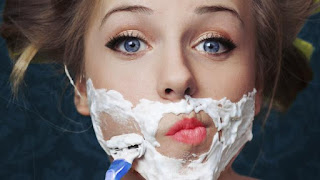 |
| The History of Shaving |
It is believed that prehistoric man would pluck out hairs using two shells. Quite inefficient, these would eventually be replaced by flint razors, which proved to be much sharper. Unfortunately for ancient men, flint razors were not very durable.
Consequently, the use of metal razors eventually developed. Approximately five thousand years ago, copper razors became moderately widespread in regions of Egypt and India. The ancient Egyptians proved to be rather extreme in the use of their shavers. It was considered unsophisticated in that society to possess any visible hair at all. To have such hair would indicate that a person was a barbarian or a criminal. This trend went to such an extreme that the entire head was shaved, resulting in the use of wigs. It is believed that such practices were begun due to hygiene, as a lack of hair deterred lice infestation and cooled down a person.
Later, in the time of Alexander the Great, shaving became more widespread, reaching Greece and eventually Rome. It was said that Alexander was so conscious of his appearance that he would not enter battle without a preliminary shave. Subsequently, for many, a short haircut and a smooth face were considered necessary as well as aesthetically pleasing.
 |
| shaving cream |
The shaver itself evolved noticeably since the middle ages. In the early 1800s, a straight razor was extremely popular. Somewhat resembling a pocketknife, the blade folded into the handle. This proved to require much maintenance and skill to use, prompting its fall to the shaver we know today. In the later half of the 1800s, the blade became perpendicular to the handle, making the product easier to use. Eventually, disposable blades became available and have proven popular ever since.
Over the past few hundred years, shaving has evolved into its modern form. The mass marketing of shaving products has exploded over the past century, partly through the growth of the media. Women, for instance, began shaving their armpits in 1915, following an advertisement in the United States displaying a woman's shaved arms. Shocking at first, this soon caught on, prompting women to shave their armpits, a trend continuing to this day in much of the western world.
 |
| shaving brush |
Shaving Techniques
- Prewash the skin using warm water in order to open pores and to soften the skin's surface. This is best performed following a bath or shower, which naturally warms and moistens the skin's surface.
- Do not use excessive amounts of shaving foam or gel. Additionally, it is best to use those which benefit the skin. Foams and gels containing vitamins for the skin, which help repair shaving damaged are available.
- Shave using a razor, not an electric shaver, for best results. Electric shavers typically operate on dry skin for best performance. They are not as accurate as a sharp razor and may more easily abrade the skin's surface.
- Be sure to use a sharp razor. Regardless of the brand, if it is not sufficiently shape, it won't produce as effective a result. In fact, the odds for damaging the skin increase significantly with an older, blunt blade.
- Shave in the direction of hair growth to reduce the blade's friction with the skin. Otherwise the blade is likely to cause damage to the skin in the form of a cut or a rash-like abrasion. An exception to this is for women shaving their legs (see women's information).
- Be sure to rinse the blade several times per shave in hot water. This will keep the blade clean and improves its performance.
- Rinse the skin with warm (not hot) water when complete. This washes away the foam or gel used and helps to restore the skin's moisture level.
- Do not use aftershave when finished. Aftershave contains alcohol, which closes the skin's pores and dries out the skin. Since the act of shaving removes skin oils, it is not a good out to dry out the skin any further. Instead, use shaving oils to replenish the skin's moisture.







0 komentar: